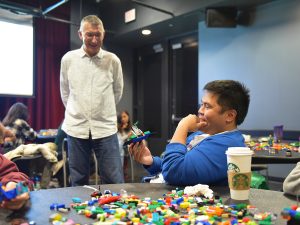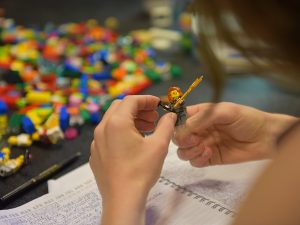Marketing Students Build Creativity, Collaboration via LEGO Serious Play
Students in the new Strategic Communication for Marketing graduate program use LEGOs to spur innovation and teamwork. Photo/Molly Loughman
By Molly Loughman
“You can tell a powerful story with a single brick,” said transformation catalyst Dieter Reuther, an operations specialist who uses LEGOs to foster innovation, leadership coaching, and team building.
Last month, Reuther visited Emerson Professor Thomas Vogel’s marketing and communication graduate class, to speak to the creative power of LEGO Serious Play. The workshop focused on the book, Beyond Advertising: Creating Value Through All Touchpoints, and the LEGO Serious Play methodology to help students elicit core insights.
According to its website, LEGO Serious Play methodology is an innovative process designed to enhance innovation and business performance. Based on research that shows this kind of hands-on, minds-on learning produces a deeper, more meaningful understanding of the world and its possibilities, the LEGO Serious Play methodology deepens the reflection process and supports an effective dialogue – for everyone in the organization.
“The whole model of advertising is shifting,” said Vogel, explaining how LEGO Serious Play exercises help to stimulate the creative communication reflection process and support an effective dialogue for those involved in the process. “It used to be that brands would bombard consumers with intriguing communication pieces. It’s now changed due to technologies and the rise of informed and critical consumers. Now, brands think in terms of people and how they make decisions — what motivates them, etc.”

“[LEGO Serious Play] makes me feel more of my creative side,” said Elyana Alajmi, Strategic Communication for Marketing graduate student.
Taught by Vogel and Senior Executive-in-Residence William Anderson, the class MK660 — Planning Seminar: Markets and Communication, is a newly developed foundational graduate course within the new graduate program, Strategic Communication for Marketing.
The new graduate program centers around how to create strategic, targeted communications that build meaningful connections between consumers and the brands they choose. The course is divided into two sections: Planning and Managing Communication; and Creating Communication. The two foci reflect specializations within the industry and represent the two tracks in which students can develop expertise, explained Vogel.
“[Anderson] represents the planning, managing, and financial side [of the course] and I, with my background, represent the creative communication, thinking, problem-solving, and the content development side. That way students are exposed to both synergies and areas of expertise,” Vogel said.
The course’s guiding text, Beyond Advertising: Creating Value Through All Touchpoints, provides a new model for how marketing communication needs to be created and implemented on the communication as well as organizational and managerial sides. Exploring concepts through LEGO Serious Play helped to embody these principles.

“[LEGO Serious Play] evokes childhood and I think that association, even subconsciously, makes you less inhibited,” said Strategic Communication for Marketing graduate student Hannah Lacava (Editor’s note: Lacava is an Emerson Today writer). “I also think it’s very much an equalizer because we all have the same exact tools in front of us, so we all have the opportunity to build whatever we want at the same level, and there’s no rules, compared to writing with a grammatical structure you need to follow.”
“I think the playful nature of it contributed a lot for me because you’re very relaxed, and that really helped bring out ideas,” said Nathaniel Ferraris, a Strategic Communication for Marketing grad student. “Incorporating fun into schoolwork or any task is really helpful.”
According to Reuther, LEGO Serious Play is being utilized in various companies, institutions, and organizations worldwide — particularly in Europe and South America — for strategy development and team-building. It is slowly growing in popularity in the U.S.
“As kids, we are all creative. Here, we go back to our core creativity and we just build and let go and come up with great ideas through storytelling and imagination,” Reuthrer said. “I’m always amazed with the powerful stories we end up with.”
Categories